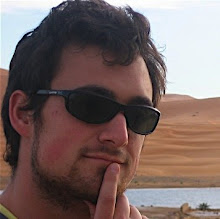We left San Salvador after four nights and headed for the small town of Alegria. This tiny mountain town (population 5000 or so) is postcard charming, perched on a green mountaintop and surrounded by beautiful flowers. Our simple hotel, a converted home, was right on the plaza and came complete with old folks sitting on wooden chairs around the garden, chatting the days away. The room we stayed in came with a large poster of Jesus' face. On arrival we walked to nearby Laguna Alegria-- a cold, sulfurous lake in the crater of a dormant volcano. We celebrated St. Patrick's Day with a few cold Pilsner beers.
After a night in Alegria we took four chicken buses and a pick-up truck east and north to the small town of Perquin, in the mountain jungle near the border with Honduras. This area was an intense battle ground during the Civil War, and our hope was to take a guided tour with a local ex-guerrilla guide. Our "hotel" was a converted wood mill, simple and super cheap ($6). One of the workers there told me times have been really tough over the past year, with tourism markedly down. He actually asked us to pay part of our stay in advance because they had no cash to buy soap, toilet paper, and food for the guests.
We ate all of our meals during our 2.5 day stay at a local eatery we found on the first night. A lovely woman cooked in the open kitchen while her husband sat watching tv and drinking beer in the dining room--he did help bring out the plates and collect our bill. She cooked up big plates of rice, salad, steak, tortillas, and beans for about $2--we really enjoyed our meals and her friendliness and, on the day we left, hugs and kisses felt natural.
On our first day we toured the local museum, filled with artifacts related to the war. It has the original radio equipment used by the guerrillas to send clandestine broadcasts to troops and supporters, 500lb American bombs dropped on the town, and bullet-proof cars donated by Mexico and France for guerrilla leaders. Evidence of the fighting is obvious 17 years later: The area is littered with tunnels, trenches, and bomb craters that would swallow a minivan.
A former combatant, Ephrain, showed us around and shared his story: He joined the guerrillas when he was 15, two years after his father and brother, non-combatants, were murdered by the military government. He took a grenade blast on one side of his body and now has limited mobility in his right arm and leg and metal plates in his head. When asked whether he believes war is useful, he said, "it was a bad thing, but we had no other choice."
While in Perquin we took an emotional trip with another ex-combatant to Mozote, where, in 1981, almost 1000 villagers were killed by soldiers attempting to eradicate the guerrilla threat. Oscar, with war scars of his own--his leg and arm were shattered by bullets--answered our questions patiently and told of his time in the war. His eyes spoke of sadness, on the verge of welling with tears as he told of his experiences: finding the bodies of decapitated children burning in Mozote, helplessly watching friends die as helicopters rained fire upon his platoon, and feeling that fighting was the only way out of a repressive situation. The one lighter moment of the trip came on the banks of the pristine Rio Sapo. We spent an hour diving and swimming in a pool set between cascades and boulders, thrilled at having found a clean body of water in Central America. We left Oscar with hearty handshakes and lingering smiles, feeling unable to truly express our gratitude at his having shared such a difficult and emotional experience.
That afternoon Jamie and I said goodbye to Ciaran as he headed for Nicaragua and we for Honduras.
Saturday, March 28, 2009
Subscribe to:
Post Comments (Atom)




No comments:
Post a Comment